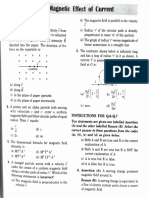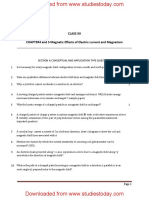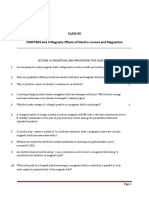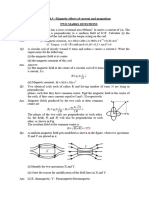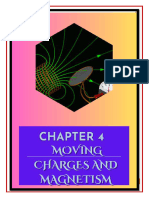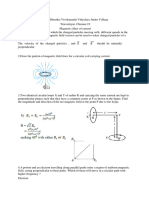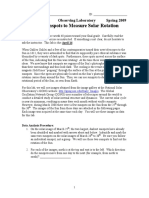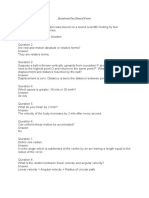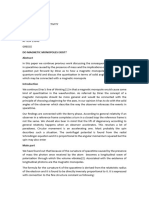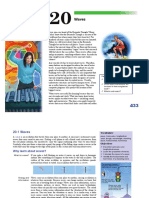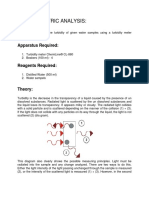EMERALD CAREER INSTITUTE- Ph:8016599734/9614650884
Ashoknagar Kachuamore,DIST-24PG NORTH West Bengal
MAGNETISM( MOVING CHARGES)
Class 12 - Physics
Time Allowed: 1 hour Maximum Marks: 50
General Instructions:
Section A MCQs
er
Section B Short Answer Question
Section C long Answer Question
are
Section D Case Study
Section E Long Answer II Ins D C Section A
1. When a charged particle moving with velocity v ⃗ is subjected to a magnetic field of induction B⃗ , the force on it is [1]
non-zero. This implies that:
a) angle between them is either zero or 180 ∘ te b) angle between them can have any value
AL
other than zero and 180 ∘
titu
c) angle between them can have any value d) angle between them is necessarily 90 ∘
other than 90 ∘
ER
2. Mass of proton is 1.6 × 10-27 kg. The proton enters the magnetic field of 2 T at an angle 30 with the direction
∘ [1]
of the field. The velocity of the proton is 2 × 107 m/ s. The radius of the path described by the proton is
EM
a) 4 cm b) 6 cm
c) 5 cm d) 3 cm
3. A circular coil A has a radius a and the current flowing in it is I. Another circular coil B has a radius 2a and if 2l [1]
is the current flowing through it, then the magnetic fields at the centre of the circular coils are in the ratio of:
a) 3 : 1 b) 4 : 1
c) 1 : 1 d) 2 : 1
4. A 10 cm long wire lies along y-axis. It carries a current of 1.0 A in positive y-direction. A magnetic field [1]
⃗ ^ ^
B = (5mT) j − (8mT) k exists in the region. The force on the wire is:
a) −(80mN)^i b) ^
−(0.8mN) i
c) (80mN)^i d) ^
(0.8mN) i
5. The electric current in a circular coil of two turns produces a magnetic induction of 0.2 T at its centre. The coil is [1]
unwound and is rewound into a circular coil of four turns. The magnetic induction at the centre of the coil now
is, in tesla
a) 0.8 b) 0.4
1/5
EMERALD GUIDANCE - Ph- 8016599734 / 9614650884
� c) 0.6 d) 0.2
6. Beams of electrons and protons move parallel to each other in the same direction. They [1]
a) attract each other. b) repel each other.
c) neither attract nor repel. d) force of attraction or repulsion depends
upon speed of beams.
7. Two charged particles, P and Q , each having charge q but of masses m and m , are accelerated through the
1 2 [1]
same potential difference V . They enter a region of magnetic field B⃗ (⊥ ⃗
v) and describe the circular paths of
m1
radii a and b respectively. Then ( m2
) is equal to:
2 2
a) ( b
)
b) (
a
)
a b
c) b
d) a
er
a b
8. A bar magnet is equivalent to [1]
are
a) toroid carrying current b) circular coil carrying current
c) solenoid carrying current d) straight conductor carrying current
9. If a conducting wire carries a direct current through it, the magnetic field associated with the current will be [1]
Ins D C
________.
a) Only inside the conductor b) Neither inside nor outside the conductor
c) Only outside the conductor te d) Both inside and outside the conductor
AL
10. A circular current loop of magnetic moment M is in an arbitrary orientation in an external magnetic field B. The [1]
titu
work done to rotate the loop by 30° about an axis perpendicular to its plane is
a) zero b)
MB
ER
–
c) MB d) √3
MB
11. Assertion: Magnetic moment of an atom is due to both, the orbital motion and spin motion of every electron. [1]
Reason: A charged particle produces a magnetic field.
EM
a) Assertion and reason both are correct b) Assertion and reason both are correct
statements and reason is correct explanation statements but reason is not correct
for assertion. explanation for assertion.
c) Assertion is correct statement but reason is d) Assertion is wrong statement but reason is
wrong statement. correct statement.
12. Assertion: A direct current flows through a metallic rod. It produces a magnetic field only outside the rod. [1]
Reason: There is no flow of charge carriers inside the rod.
a) Assertion and reason both are correct b) Assertion and reason both are correct
statements and reason is correct explanation statements but reason is not correct
for assertion. explanation for assertion.
c) Assertion is correct statement but reason is d) If both assertion and reason are false.
wrong statement.
13. Assertion (A): For a given charged particle moving in a given magnetic field, the radius of circular path is [1]
directly proportional to the momentum of particle.
2/5
EMERALD GUIDANCE - Ph- 8016599734 / 9614650884
� Reason (R): The effect of magnetic field on a charged particle, change only its path from linear to circular.
a) Both A and R are true and R is the correct b) Both A and R are true but R is not the
explanation of A. correct explanation of A.
c) A is true but R is false. d) A is false but R is true.
Section B
14. Write any two important points of similarities and differences each between Coulomb's law for the electrostatic [2]
field and Biot-Savart's law for the magnetic field.
15. Two identical coils P and Q each of radius R are lying in perpendicular planes such that they have a common [2]
centre. Find the magnitude and direction of the magnetic field at the common centre when they carry currents
–
equal to I and √3 I respectively.
er
are
A charged particle q is moving in the presence of a magnetic field B which is inclined to an angle 30o with the [2]
16.
Ins D C
direction of the motion of the particle. Draw the trajectory followed by the particle in the presence of the field
and explain how the particle describes this path.
17. te
a. Show how Biot-Savart law can be alternatively expressed in the form of Ampere's circuital law. Use this law [2]
AL
to obtain the expression for the magnetic field inside a solenoid of length T, cross-sectional area A having N
titu
closely wound turns and carrying a steady current I
b. Sketch the magnetic field lines for a finite solenoid. Explain why the field at the exterior midpoint is weak
while at the interior it is uniform and strong.
ER
18. A deuteron and an alpha particle having same momentum are in turn allowed to pass through a magnetic field B⃗ , [2]
acting normal to the direction of motion of the particles. Calculate the ratio of the radii of the circular paths
described by them.
EM
19. When a galvanometer having 30 divisions scale and 100 Ω resistance is connected in series to a battery of emf 3 [2]
V through a resistance of 200 Ω shows full scale deflection. Find the figure of merit of the galvanometer in μ A.
OR
A wire of length l carries a current I along the X-axis. A magnetic field B⃗ = ^ ^ ^
B0 ( i + j + k) tesla exists in space.
Find the magnitude of the magnetic force on the wire.
Section C
20. The magnitude F of the force between two straight parallel current-carrying conductors kept at a distance d apart [3]
μ0 I1 I2
in the air is given by F = 2π
⋅
d
where I1 and I2 are the currents flowing through the two wires
Use this expression, and the sign convention that the: " Force of attraction is assigned a negative sign and force
of repulsion assigned a positive sign". Draw graphs showing the dependence of F on:
i. I1I2 when d kept constant
ii. when the product I1I2 is maintained at a constant positive value.
iii. when the product I1I2 is maintained at a constant negative value.
21. Derive the expression for the torque τ acting on a rectangular current loop of area A placed in a uniform [3]
3/5
EMERALD GUIDANCE - Ph- 8016599734 / 9614650884
� magnetic field B. Show that τ ⃗ = m⃗ × B
⃗
where m⃗ is the magnetic moment of the current loop given by
⃗
m⃗ = I A
22. A circular coil of 20 turns and a radius of 10 cm is placed in a uniform magnetic field of 0.10 T normal to the [3]
plane of the coil. If the current in the coil is 5.0 A, what is the
a. total torque on the coil,
b. the total force on the coil,
c. average force on each electron in the coil due to the magnetic field?
(The coil is made of copper wire of cross-sectional area 10–5 m2, and the free electron density in copper is given
to be about 1029 m–3)
23. Why is the magnetic field radial in a moving coil galvanometer? Explain how it is achieved. [3]
OR
er
The deflection produced in a galvanometer is reduced to 45 divisions from 55 when a shunt of 8 μ is used. Calculate
the resistance of the galvanometer.
are
24. A straight wire carrying a current of 12 A is bent into a semi-circular arc of radius 2.0 cm as shown in Fig. (a). [3]
Consider the magnetic field B at the centre of the arc.
a. What is the magnetic field due to the straight segments?
Ins D C
b. In what way the contribution to B from the semicircle differs from that of a circular loop and in what way
does it resemble?
c. Would your answer be different if the wire were bent into a semi-circular arc of the same radius but in the
opposite way as shown in Fig. (b)?
te
AL
titu
ER
Section D
EM
25. A rectangular loop of metallic wire is of length a and breadth b and carries current I. Find the magnitude of the [5]
magnetic field at the centre O of the loop.
OR
A proton, travelling in a vacuum at a speed of 4.5 × 106 ms-1, enter a region of the uniform magnetic field of flux
density 0.12T. The path of the proton in the field is a circular arc, as illustrated in Fig.
a. i. State the direction of the magnetic field.
ii. Calculate the radius of the path of the proton in the magnetic field.
b. A uniform electric field is now created in the same region as the magnetic field in the figure, so that the proton
passes undeviated through the region of the two field
i. Predict the direction of the electric field.
4/5
EMERALD GUIDANCE - Ph- 8016599734 / 9614650884
� ii. Calculate the magnitude of the electric field strength.
c. Suggest why gravitational forces on the proton have not been considered in the calculations in (a) and (b).
26. Read the text carefully and answer the questions: [5]
When a rectangular loop PQRS of sides a and b carrying current I is placed in uniform magnetic field B⃗ , such
that area vector A⃗ makes an angle θ with the direction of the magnetic field, then forces on the arms QR and SP
of loop are equal, opposite and collinear, thereby perfectly cancel each other, whereas forces on the arms PQ and
RS of loop are equal and opposite but not collinear, so they give rise to torque on the loop.
er
are
Force on side PQ or RS of loop is F = IbB sin 90o = IbB and perpendicular distance between two non-collinear
forces is r1 = a sin θ Ins D C
te
AL
So, torque on the loop, τ = I AB sin θ
titu
In vector form torque, τ ⃗ = ⃗
M × B
⃗
⃗
where M⃗ = NIA is called magnetic dipole moment of current loop and is directed in direction of area vector A⃗
ER
i.e., normal to the plane of loop.
(a) A circular loop of area 1 cm2, carrying a current of 10 A is placed in a magnetic field of 0.1 T
perpendicular to the plane of the loop. Calculate the torque acting on the loop due to the magnetic field.
EM
(b) Write the relation between magnetic moment and angular velocity of the coil.
(c) A current loop is lying in a magnetic field, what are conditions for it to be in stable and unstable
equilibrium?
(d) How does the magnetic moment of a current I carrying circular coil of radius r and number of turns N
varies with radius of the coil?
(e) A rectangular coil carrying current is placed in a non-uniform magnetic field. Will it experience any force
or torque?
5/5
EMERALD GUIDANCE - Ph- 8016599734 / 9614650884

